
# C64 - 1962 8c Plane & Capitol,carmine
Â
1962 8¢ Airliner and Capitol Dome
Â
Â
Congress’s First Session in the U.S. Capitol
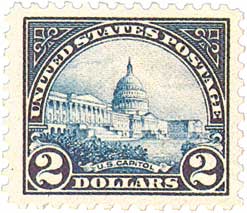
On November 17, 1800, Congress convened in the still-under-construction Capitol Building in Washington, DC, for the first time. The Capitol Building would undergo several expansions over the years, eventually growing to 16.5 acres.
Between 1776 and 1800, the US had nine different capitals. In 1787, the delegates at the Philadelphia Convention granted Congress the power to establish a national capital from land ceded by the states.  Eventually, James Madison, Thomas Jefferson, and Alexander Hamilton selected the area around the Potomac River to serve as the national capital.
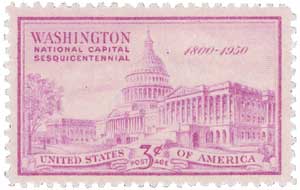
Pierre Charles L’Enfant designed the capital city to revolve around the US Capitol Building on top of Jenkins Hill. L’Enfant was eventually let go over conflicts with city commissioners and replaced by Andrew Ellicot. He made several changes to L’Enfant’s plan and had it engraved, making it the first distributed plan of the city.
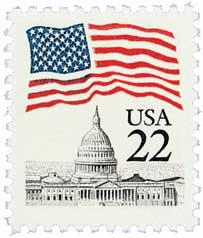
With L’Enfant’s departure, a new architect was needed to design the Capitol. Thomas Jefferson suggested they hold a design competition. Though most of the Capitol building designs were unusable, President Washington praised a late entry by William Thornton for its “Grandeur, Simplicity, and Beauty.â€Â Thornton’s design was in part inspired by the east front of the Louvre as well as the Paris Pantheon. His design was approved, with modifications by Benjamin Henry Latrobe, and planning began immediately.
Excavation of the Capitol site began in July 1793. Two months later, President Washington laid the cornerstone on September 18. Work on the Capitol progressed slowly, as the costs of materials and labor were higher than expected. In 1796, the building’s planners decided to focus their efforts on the north wing, so some part of the building could open relatively soon.
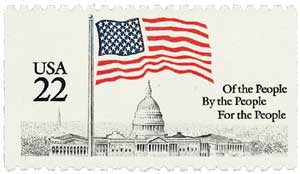
By the Fall of 1800, most of the north wing was complete, with space for the Senate, the House, the Supreme Court, the Library of Congress, and district courts. The first meetings of the Senate and House in the new Capitol Building convened on November 17. It marked the start of the second session of the 6th US Congress. However, a bad storm had hit the east coast, making it difficult for some of the Congressmen to make it to Washington on time. When the Senate first met on that day, only 15 members were present – but 17 were required for the quorum. It was four days before enough Senators arrived to officially convene.
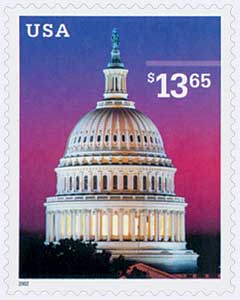
The Senate and House then notified President John Adams that they were officially in session. President Adams visited the Capitol the next day to deliver his annual address to a joint session of Congress. The president congratulated Congress on their new seat of government and said, “Although there is some cause to apprehend that accommodations are not now so complete as might be wished, yet there is great reason to believe that this inconvenience will cease with the present session.â€
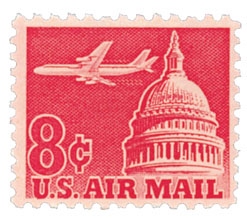
Work on the Capitol Building continued and was completed shortly before it was destroyed by the British during the War of 1812. Construction on the Capitol began again 1815 and new Senate and House chambers were completed in 1819. A center section, columned portico, and interior rotunda were completed in 1826. However, by 1850, it became apparent that the Capitol couldn’t hold the increasing number of legislators from newly admitted states. A design competition was held, and two new wings were added, with a new chamber for the House of Representatives on the south side and the Senate on the north. This expansion more than doubled the length of the Capitol, making its original dome look out of proportion, so a new dome was also added. The Capitol underwent further changes in the years to come and was declared a National Historic Landmark in 1960. Its last extension was completed in 1962. The US Capitol Visitor Center opened in 2008.
Â
Â
1962 8¢ Airliner and Capitol Dome
Â
Â
Congress’s First Session in the U.S. Capitol

On November 17, 1800, Congress convened in the still-under-construction Capitol Building in Washington, DC, for the first time. The Capitol Building would undergo several expansions over the years, eventually growing to 16.5 acres.
Between 1776 and 1800, the US had nine different capitals. In 1787, the delegates at the Philadelphia Convention granted Congress the power to establish a national capital from land ceded by the states.  Eventually, James Madison, Thomas Jefferson, and Alexander Hamilton selected the area around the Potomac River to serve as the national capital.

Pierre Charles L’Enfant designed the capital city to revolve around the US Capitol Building on top of Jenkins Hill. L’Enfant was eventually let go over conflicts with city commissioners and replaced by Andrew Ellicot. He made several changes to L’Enfant’s plan and had it engraved, making it the first distributed plan of the city.

With L’Enfant’s departure, a new architect was needed to design the Capitol. Thomas Jefferson suggested they hold a design competition. Though most of the Capitol building designs were unusable, President Washington praised a late entry by William Thornton for its “Grandeur, Simplicity, and Beauty.â€Â Thornton’s design was in part inspired by the east front of the Louvre as well as the Paris Pantheon. His design was approved, with modifications by Benjamin Henry Latrobe, and planning began immediately.
Excavation of the Capitol site began in July 1793. Two months later, President Washington laid the cornerstone on September 18. Work on the Capitol progressed slowly, as the costs of materials and labor were higher than expected. In 1796, the building’s planners decided to focus their efforts on the north wing, so some part of the building could open relatively soon.

By the Fall of 1800, most of the north wing was complete, with space for the Senate, the House, the Supreme Court, the Library of Congress, and district courts. The first meetings of the Senate and House in the new Capitol Building convened on November 17. It marked the start of the second session of the 6th US Congress. However, a bad storm had hit the east coast, making it difficult for some of the Congressmen to make it to Washington on time. When the Senate first met on that day, only 15 members were present – but 17 were required for the quorum. It was four days before enough Senators arrived to officially convene.

The Senate and House then notified President John Adams that they were officially in session. President Adams visited the Capitol the next day to deliver his annual address to a joint session of Congress. The president congratulated Congress on their new seat of government and said, “Although there is some cause to apprehend that accommodations are not now so complete as might be wished, yet there is great reason to believe that this inconvenience will cease with the present session.â€

Work on the Capitol Building continued and was completed shortly before it was destroyed by the British during the War of 1812. Construction on the Capitol began again 1815 and new Senate and House chambers were completed in 1819. A center section, columned portico, and interior rotunda were completed in 1826. However, by 1850, it became apparent that the Capitol couldn’t hold the increasing number of legislators from newly admitted states. A design competition was held, and two new wings were added, with a new chamber for the House of Representatives on the south side and the Senate on the north. This expansion more than doubled the length of the Capitol, making its original dome look out of proportion, so a new dome was also added. The Capitol underwent further changes in the years to come and was declared a National Historic Landmark in 1960. Its last extension was completed in 1962. The US Capitol Visitor Center opened in 2008.
Â












